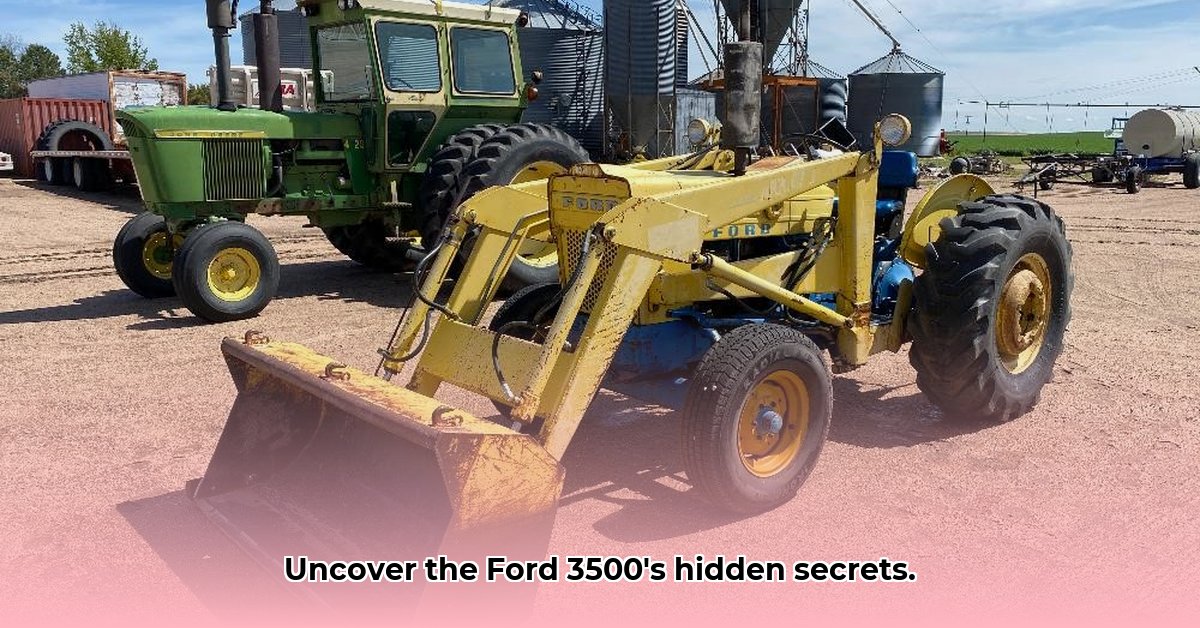
The Ford 3500 tractor, a stalwart of the 1960s and 70s agricultural landscape, presents a unique challenge for historians and enthusiasts alike: a fascinating machine with surprisingly inconsistent documentation. This article aims to provide a comprehensive overview of the Ford 3500, exploring its history, technical specifications, available attachments, and practical restoration guidance, acknowledging the inherent ambiguities in the available data. For more detailed Ford tractor specifications from 1920 onwards, see this helpful resource: Ford Tractor Specs.
A Workhorse Shrouded in Mystery: The Ford 3500's History
Produced between approximately 1965 and 1972, the Ford 3500 quickly established itself as a versatile workhorse. Its adaptability stemmed from a range of engine and transmission options, combined with a wide array of compatible attachments. However, the very factors contributing to its versatility—regional variations in manufacturing and less meticulous record-keeping—also create challenges in establishing a definitive set of specifications. This lack of consistent documentation makes researching the Ford 3500 a captivating, if sometimes frustrating, endeavor. The agricultural landscape of the era, with its increasing mechanization and regional differences in farming practices, further complicates the task of compiling complete and precise technical data.
Unveiling the Specs: Engine, Transmission, and PTO Options
Determining the exact specifications of a Ford 3500 requires careful consideration of multiple sources, often revealing inconsistencies and gaps in information. The most common engine choices were a 2.6-liter gasoline engine or a 2.9-liter diesel engine, but minor variations in horsepower (around 46 hp) existed, possibly due to differing measurement methods or slight engine modifications. The available transmissions varied significantly. The most common choices were 4-speed mechanicals, 6-speed mechanical shuttles, 4-speed power shuttles, and even 10-speed units. The PTO (Power Take-Off) specifications also varied depending on the chosen engine and transmission combination, adding further complexity to the puzzle.
Here's a summary of the known variations, acknowledging data uncertainties:
| Feature | Options | Notes |
|---|---|---|
| Engine | 2.6L Gasoline, 2.9L Diesel | Power output varied slightly depending on engine type and PTO configuration. |
| Transmission | 4-speed, 6-speed mechanical shuttle, 4-speed power shuttle, 10-speed | Exact gear ratios and speeds varied across models and years; precise data is often unavailable. |
| PTO | Varied with engine and transmission options | Comprehensive PTO specifications are frequently lacking in historical documentation. |
Expanding Utility: Attachments and Accessories
The Ford 3500's versatility significantly expanded through its compatibility with various attachments. Popular choices included the Ford 735 Loader, and the Ford 750 & 753 backhoes, transforming the tractor into a versatile tool for a wide range of applications from moving materials to excavating. Determining which attachments were compatible with specific tractor configurations requires meticulous investigation.
Restoring the Legend: A Practical Restoration Guide
Restoring a Ford 3500 can be both rewarding and challenging. The scarcity of original parts often necessitates creative sourcing strategies. Online forums devoted to vintage Ford tractors are crucial resources, not only for parts but also for invaluable advice from fellow enthusiasts.
Step-by-Step Restoration:
- Comprehensive Inspection: Begin with a thorough examination of the tractor's condition, documenting all aspects (good and bad) for future reference.
- Strategic Parts Sourcing: Prioritize original Ford parts. If unavailable, investigate reputable aftermarket alternatives but be mindful of potential quality variations.
- Expert Assistance: Don't hesitate to seek professional guidance from mechanics with experience restoring vintage tractors.
- Rigorous Testing: After restoration, thorough testing is crucial, allowing for fine-tuning and ensuring optimal performance.
Conclusion: The Enduring Appeal of the Ford 3500
The Ford 3500 remains a fascinating subject for tractor enthusiasts. Its adaptability and inherent strength contributed to its popularity. While compiling a fully comprehensive technical record remains a challenge due to the inconsistencies of the historical data, the Ford 3500's enduring legacy underscores its importance in shaping agricultural practices during a period of rapid mechanization. Its story, constantly being rewritten through restoration and rediscovery, continues to captivate enthusiasts today.